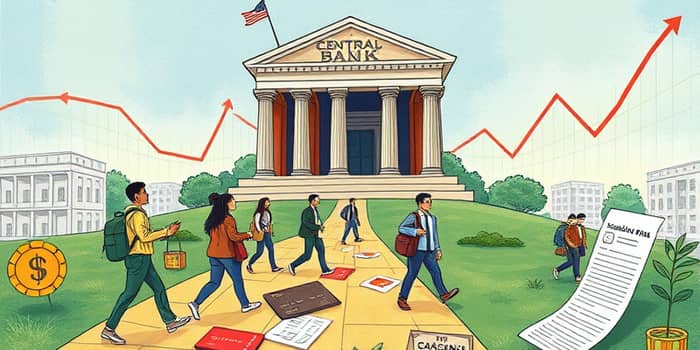
The United States is witnessing a pronounced moderation in consumer borrowing as monetary policy enters tightening mode.
Total outstanding U.S. consumer credit reached $5.01 trillion in Q1 2025, marking one of the slowest expansion phases in recent history.
As rates remain elevated and liquidity contracts, households and lenders alike are rethinking their credit strategies.
Tightening cycles occur when central banks raise policy rates and shrink their balance sheets to fight inflation.
The Federal Reserve initiated rate hikes in 2022 and engaged in quantitative tightening campaigns by the Fed, reducing excess liquidity in financial markets.
These measures aim to cool price pressures but also raise the cost of borrowing for consumers and businesses.
In Q1 2025, overall consumer credit grew at a 1.53% seasonally adjusted annual rate—among the slowest quarterly gains of the past decade.
Year-over-year expansion eased to 1.93%, reflecting both lower demand for new credit and higher interest expenses on existing balances.
Even after the Fed cut the federal funds rate by 100 basis points late in 2024, rates on credit cards and auto loans remain historically high.
Growth patterns differ markedly across credit categories, underscoring divergent borrower behaviors and risk assessments.
Multiple factors converge to temper borrowing, reshaping household balance sheets in the process.
Credit card balances expanded at a modest 2.3% annual pace, the weakest surge in several years as borrowers grapple with high rates and tighter issuer criteria.
Auto loan growth slowed dramatically to 0.26% year-over-year, the lowest rate since 2010. New 60-month loans averaged 8.04% in Q1 2025, discouraging many buyers.
Student loan balances rose 2.48% as pandemic-era forbearance ended. Younger and lower-income borrowers exhibited greater hesitation, while older, higher-income households remained more resilient.
Total consumer balances climbed 28% from Q1 2020 to Q1 2025 in nominal terms, but inflation-adjusted balances grew by only about 4%.
This divergence highlights debt inflation outpacing real borrowing growth, indicating price rises rather than true expansion in credit usage.
The labor market remains relatively tight, with solid wage gains offering some buffer against higher debt servicing costs.
However, rising mortgage delinquencies contrast with improving auto and bankcard default rates, reflecting uneven sectoral stress across households.
Global tightening by other central banks could spill over, adding pressure on U.S. financial conditions and consumer confidence.
Moderating credit growth may help contain financial vulnerabilities, yet could signal a slowdown in consumption-driven economic momentum.
Reduced borrowing can weigh on retail sales, auto purchases, and higher-education financing, with potential spillovers to broader GDP growth.
With the Fed signaling gradual rate adjustments and inflation lingering above target, credit growth is poised to remain subdued through 2025.
Household balance sheets, though stronger than in past cycles, will face continued pressure if rates stay elevated and price pressures persist.
As fiscal policy remains in flux and global liquidity conditions evolve, ongoing vigilance by consumers, lenders, and regulators will be essential.
References













